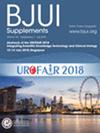实验石清除范围内吸和灵活的和可导航的吸入口护套。
IF 4.4
2区 医学
Q1 UROLOGY & NEPHROLOGY
引用次数: 0
摘要
目的开展直接镜内吸引输尿管镜(DISS)的实验研究。3.6-Ch和5.1-Ch工作通道)和灵活可导航的吸引(FANS)输尿管通路鞘(ClearPetra;Wellead,广州,中国)建立他们清除不同直径的石头的能力。对于每个实验组,我们进行了一系列实验,使用逐渐增大的石头颗粒(250 μm和bb0 - 500 μm(具有3.6-Ch和5.1-Ch的工作通道)的混合物可以阻塞输尿管镜。使用FANS,通过成功清除较大的碎片,可以促进清除较大的碎片。本文章由计算机程序翻译,如有差异,请以英文原文为准。
Experimental stone clearance with in-scope suction and flexible and navigable suction access sheaths.
OBJECTIVE
To perform benchtop experiments using direct in-scope suction (DISS) ureteroscopes (Pusen Medical, Zhuhai, China; 3.6-Ch and 5.1-Ch working channels) and flexible and navigable suction (FANS) ureteric access sheaths (ClearPetra; Wellead, Guangzhou, China) to establish their ability to clear stones of different diameters.
METHODS
For each experimental group, we conducted a series of experiments using mixes of progressively larger stone particles (<63, 63-125, 125-250, 250-500, 500-1000 and 1000-2000 μm) until suction through the respective lumen failed to achieve complete stone clearance; the first experiment's stone mix contained particles <63 μm; the second experiment's stone mix contained particles <63 μm + 63-125 μm; the third experiment's stone mix contained particles <63 μm + 63-125 μm + 125-250 μm, and so on, up to 2000 μm. The stone mixes were introduced in aliquots over the course of 30 min. In the first experimental group, either a 3.6-Ch or a 5.1-Ch working channel DISS ureteroscope (with a 200-μm laser) was used to aspirate stones. In the second experimental group, either an empty 5.1-Ch working channel DISS ureteroscope or an 11/13-Ch FANS with a 9.5-Ch ureteroscope (intermittently withdrawn) was used to aspirate stones.
RESULTS
The use of DISS through a 3.6-Ch working channel (with laser fibre) cleared stones up to 250 μm. DISS through a 5.1-Ch working channel cleared stones up to 500 μm with and without an indwelling laser fibre. FANS cleared all stone sizes tested (up to 2000 μm).
CONCLUSIONS
During laser lithotripsy, DISS can aspirate 'dust' particles (<250 μm), which are known to most affect vision. However, particles >250 μm and >500 μm (with 3.6-Ch and 5.1-Ch working channels) may block the ureteroscope. The use of FANS, through successful clearance of larger fragments, may facilitate clearance of larger fragments.
求助全文
通过发布文献求助,成功后即可免费获取论文全文。
去求助
来源期刊

BJU International
医学-泌尿学与肾脏学
CiteScore
9.10
自引率
4.40%
发文量
262
审稿时长
1 months
期刊介绍:
BJUI is one of the most highly respected medical journals in the world, with a truly international range of published papers and appeal. Every issue gives invaluable practical information in the form of original articles, reviews, comments, surgical education articles, and translational science articles in the field of urology. BJUI employs topical sections, and is in full colour, making it easier to browse or search for something specific.
 求助内容:
求助内容: 应助结果提醒方式:
应助结果提醒方式:


